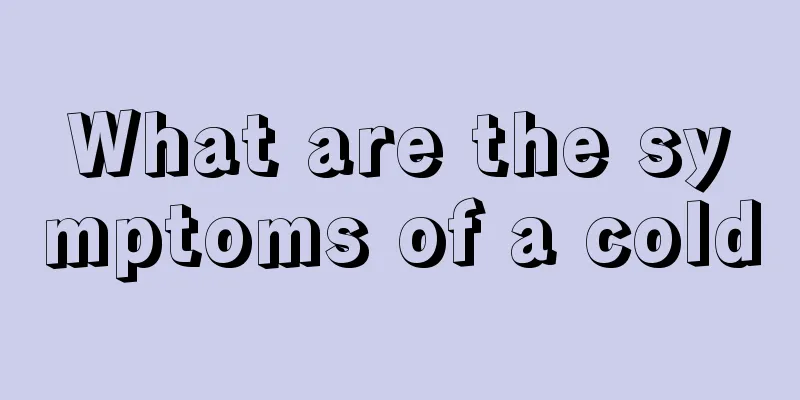What are the symptoms of a cold

|
Generally speaking, when people show the slightest cold symptom, they should go to the hospital for treatment in time, because this will prevent the cold from developing to a serious level, which would make it very difficult to treat. As the most common disease in the human body, colds have many symptoms, and some of them are quite torturous to people. Let's learn about some symptoms of colds today. Clinical manifestations: The incubation period of a cold is 1-3 days, the shortest being just a few hours and the longest being up to 4 days. Simple influenza: more common. The patient has an acute onset of high fever, with severe systemic symptoms but not severe respiratory symptoms. Symptoms include chills, fever, headache, fatigue, body aches, etc. Symptoms include chills, fever, headache, fatigue, body aches, etc., and the body temperature can reach 39-40℃. After lasting for 2-3 days, the symptoms gradually subside and the systemic symptoms gradually improve, but symptoms of upper respiratory tract infection such as nasal congestion, runny nose, sneezing, sore throat, and dry cough are often more obvious. A few may have mild gastrointestinal symptoms. Physical examination shows acute illness, flushed cheeks, mild congestion of the conjunctiva, tenderness of the eyeballs, congestion of the pharynx, and herpes on the oral mucosa. Pneumonia-type influenza: less common. It mainly occurs in patients with existing cardiopulmonary diseases or pregnant women. The clinical manifestations include persistent high fever, shortness of breath, cyanosis, paroxysmal cough, hemoptysis, etc. Physical examination revealed low, full-blown wheezing sounds in both lungs, but no signs of consolidation. The course of the disease may last up to 3-4 weeks. When combined with bacterial infection, it may present as bronchopneumonia or lobar pneumonia. Symptoms include severe cough, purulent sputum, chest pain, lung consolidation or focal pneumonia signs. Toxic influenza: Pneumonia lesions are not obvious, but there is systemic damage to the vascular and nervous systems. There are obvious encephalitis lesions, persistent high fever, confusion, and often delirium. A few cases may suffer from low blood pressure or shock due to vascular nervous system dysfunction or adrenal bleeding. Others: After being infected with the influenza virus, only mild symptoms such as fever, cough, and discomfort may occur. The course of the disease is 1-2 days, similar to other viral upper respiratory tract infections, and is called mild influenza. A small number of patients present with gastrointestinal symptoms such as abdominal pain and diarrhea, which is called gastrointestinal influenza. Specific performance: 1. Wind-cold type cold: headache and fever, no sweat, fear of cold, soreness and fatigue in the limbs, nasal congestion, clear runny nose, thin white tongue coating, and floating and tight pulse. 2. Wind-heat type cold: fever, headache, little sweat, dry mouth, mild fear of cold, sore throat, runny nose, coughing up yellow phlegm, constipation, yellow and red urine, thin yellow tongue coating, and floating and rapid pulse. 3. When secondary upper respiratory tract infection occurs, there may be cough. When secondary bronchitis and lung infection occur, there may be cough, chest pain, rales on lung auscultation, and increased total white blood cell count and neutrophil count in the blood; it may also be complicated by otitis media, sinusitis, etc. Warm reminder: The editor reminds everyone to pay attention to these symptoms in daily life and respond to treatment in time. You must also do a good job of prevention in daily life. You can strengthen physical exercise to improve your body's immunity. If you have a cold, you should seek treatment in time to avoid delaying the disease and causing unnecessary consequences. |
<<: Why do I catch colds so often?
>>: How to cure a cold quickly without taking medicine
Recommend
Difference between rhinitis and nasopharyngeal carcinoma nasal congestion
For the student group, due to the sharp increase ...
Small blisters on fingers
Many people cannot stand the hot weather in the s...
How long is the survival period of nasopharyngeal carcinoma and what is the treatment for the first stage?
For many people today, early treatment of nasopha...
What to do if back pain often occurs after bowel cancer surgery
What should I do if I often have back pain after ...
Can metastatic rectal cancer be cured?
If we do not maintain good eating habits in our l...
How to take a hot spring bath
When it comes to hot spring bathing, I believe mo...
What to do if your neck hurts when you wake up
Neck pain is a problem that many people have enco...
Five indicators of blocking antibodies
The reason why the human body gets disease is not...
What are the reactions of gastric cancer patients after chemotherapy? Pay attention to these four reactions
At present, the reaction after chemotherapy is th...
How much does a throat cancer check cost?
The incidence of diseases such as laryngeal cance...
Advanced symptoms of gastric cancer in women
Symptoms of advanced gastric cancer in women: Gas...
Are hormones harmful to the body?
Hormones are a substance that we often come into ...
Is it good to wash your face with milk every day
If you use milk to wash your face, it can produce...
Can malignant bile duct cancer be cured?
Many cancer patients are afraid of cancer, becaus...
The hair care effect of geranium essential oil
There are many types of essential oils. When choo...









